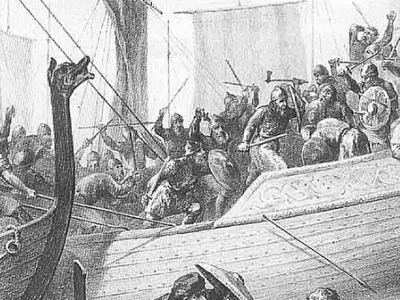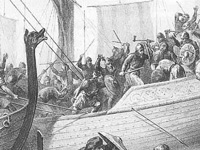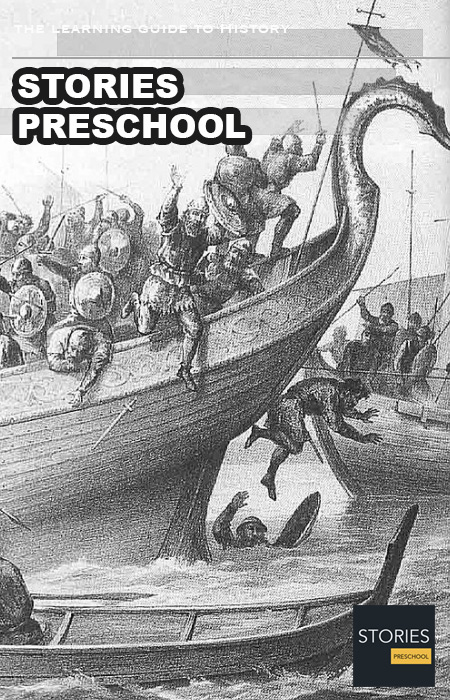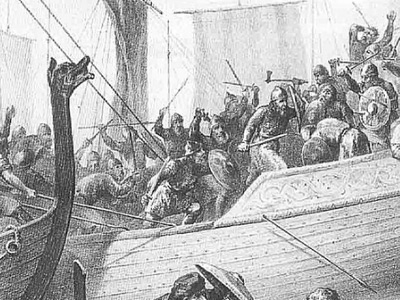Battle of Svolder (1000)

The Battle of Svolder (Svold or Swold) was a naval battle fought in September 999 or 1000 in the western Baltic Sea between King Olaf Tryggvason of Norway and an alliance of his enemies. The backdrop of the battle was the unification of Norway into a single state, long-standing Danish efforts to gain control of the country, and the spread of Christianity in Scandinavia.
King Olaf was sailing home after an expedition to Wendland (Pomerania), when he was ambushed by an alliance of Svein Forkbeard, King of Denmark, Olof Skötkonung (also known as Olaf Eiríksson), King of Sweden, and Eirik Hákonarson, Jarl of Lade. Olaf had only 11 warships in the battle against a fleet of at least 70. His ships were captured one by one, last of all the Ormen Lange, which Jarl Eirik captured as Olaf threw himself into the sea. After the battle, Norway was ruled by the Jarls of Lade as a fief of Denmark and Sweden.
The exact location of the battle is disputed, and depends on which group of sources is preferred: it is only Icelandic sources that place it near a place called Svolder, while Adam of Bremen places it in Øresund.
The most detailed sources on the battle, the kings' sagas, were written approximately two centuries after it took place. Historically unreliable, they offer an extended literary account describing the battle and the events leading up to it in vivid detail. The sagas ascribe the causes of the battle to Olaf Tryggvason's ill-fated marriage proposal to Sigrid the Haughty and his problematic marriage to Thyri, sister of Svein Forkbeard. As the battle starts Olaf is shown dismissing the Danish and Swedish fleets with ethnic insults and bravado while admitting that Eirik Hákonarson and his men are dangerous because "they are Norwegians like us". The best known episode in the battle is the breaking of Einarr Þambarskelfir's bow, which heralds Olaf's defeat.
In later centuries, the saga descriptions of the battle, especially that in Snorri Sturluson's Heimskringla, have inspired a number of ballads and other works of literature.
Time and location
All sources which date the battle agree that it took place in 1000. The oldest source to date it is the meticulous Íslendingabók, written around 1128, which specifies that it took place in the summer. Oddr Snorrason says further that the battle is "memorialized for the fallen men on the Third or Fourth Ides of September", (10 or 11 September). Mesta states that the battle occurred on 9 September, and other sources agree with either date. Since some medieval writers reckoned the end of the year in September, it is possible that the year referred to is in fact the one we know as 999.
The location of the battle cannot be identified with any certainty. According to Adam of Bremen, it took place in Oresund. Ágrip and Historia Norwegie also place it off Zealand. Theodoricus says it took place "beside the island which is called Svöldr; and it lies near Slavia". Fagrskinna speaks of "an island off the coast of Vinðland... [t]his island is called Svölðr." Oddr Snorrason and Heimskringla agree on the island's name but do not specify its location. A stanza by Skúli Þórsteinsson speaks of "the mouth of Svolder", suggesting that Svolder was originally the name of a river which Norse unfamiliarity with Wendish geography turned into an island. The Danish Annales Ryenses are unique in placing the battle in the Schlei. Modern historians are divided, some locating the confrontation near the German island of Rügen while others prefer Oresund.
HISTORY

RESOURCES
This article uses material from the Wikipedia article "Battle of Svolder (1000)", which is released under the Creative Commons Attribution-Share-Alike License 3.0.
© Stories Preschool. All Rights Reserved.










